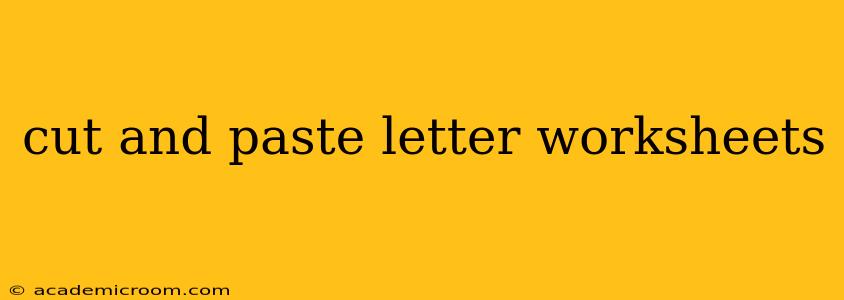Cut and paste letter worksheets are invaluable tools for young learners, offering a fun and engaging way to develop essential pre-reading and literacy skills. These activities help children improve fine motor skills, letter recognition, and phonics understanding. This guide explores the various types of cut and paste letter worksheets available, their benefits, and how to effectively incorporate them into learning.
What are Cut and Paste Letter Worksheets?
Cut and paste letter worksheets typically involve cutting out individual letters or letter combinations (like CVC words) and pasting them onto designated areas on a worksheet. The activities vary in complexity, catering to different age groups and skill levels. Simpler worksheets might focus on matching uppercase and lowercase letters, while more advanced versions could involve creating words, sentences, or even short stories.
Benefits of Using Cut and Paste Letter Worksheets
The benefits of incorporating cut and paste letter worksheets into early childhood education are numerous:
- Improved Fine Motor Skills: The act of cutting and pasting strengthens small muscles in the hands and fingers, crucial for writing and manipulating objects later on.
- Enhanced Letter Recognition: Repeatedly handling and placing letters reinforces visual memory and helps children recognize the shapes and forms of letters.
- Boosted Phonics Skills: Worksheets focusing on letter sounds and word building directly support phonics development, a cornerstone of reading comprehension.
- Increased Hand-Eye Coordination: Precise cutting and pasting requires careful hand-eye coordination, further contributing to overall motor skill development.
- Engaging Learning Experience: The hands-on nature of these worksheets makes learning more fun and interactive, encouraging active participation.
Types of Cut and Paste Letter Worksheets
There's a wide variety of cut and paste letter worksheets available to suit different learning objectives:
- Uppercase and Lowercase Matching: Children match uppercase letters to their lowercase counterparts, reinforcing the relationship between the two forms.
- Letter Sound Matching: This focuses on connecting letters to their corresponding sounds, supporting phonetic awareness.
- Word Building: Children cut out individual letters and arrange them to create simple words.
- Sentence Building: An advanced version where children create sentences using cut-out letters and words.
- Picture and Letter Matching: Children match pictures to the initial letter of the object depicted.
- Theme-Based Worksheets: Worksheets incorporating specific themes (animals, vehicles, etc.) to add interest and context.
How to Create Your Own Cut and Paste Letter Worksheets
Creating your own worksheets allows for customization to suit individual needs and learning styles. You can easily use word processing software or drawing programs to design your own. Consider using:
- Clear and Large Letters: Ensure letters are easily identifiable, especially for younger children.
- Bold Outlines: Thicker outlines make cutting easier and more precise.
- Visually Appealing Designs: Adding colors and pictures makes the worksheets more engaging.
- Age-Appropriate Complexity: Adjust the difficulty based on the child's skill level.
Where to Find Printable Cut and Paste Letter Worksheets
Numerous websites offer free and printable cut and paste letter worksheets. A simple online search should provide a wide selection. Remember to check the quality and suitability of the worksheets before printing.
Troubleshooting Common Challenges
- Difficulty Cutting: Use scissors with rounded tips for safety. Practice cutting skills with other activities before tackling worksheets.
- Messy Pasting: Use a glue stick for easier control and less mess. Show children how to apply a thin layer of glue.
- Frustration: Break down complex tasks into smaller, more manageable steps. Provide positive reinforcement and encouragement.
By incorporating cut and paste letter worksheets into your teaching or parenting strategies, you can provide children with a fun, engaging, and effective way to learn crucial pre-reading skills. Remember to adapt the activities to the child's age and ability for optimal learning.
